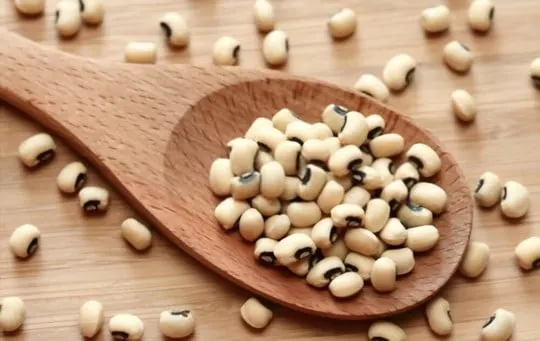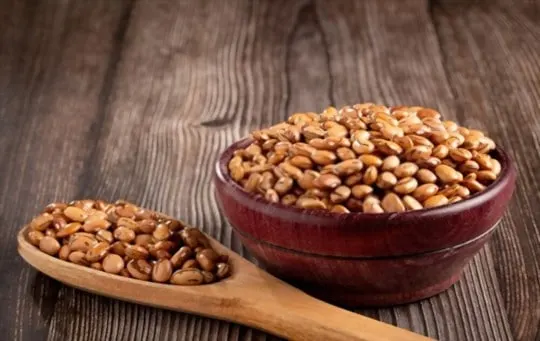In the grand scheme of dinner plans, beans are a big deal.
Black Eyed Peas and Pinto Beans stand front and center. They’re not just food; they’re a lifestyle.
We’ve all been there, staring at the pantry, trying to make a choice.
Black Eyed Peas? They bring luck, especially if you eat them on New Year’s Day. Or so my grandma swears by.
Pinto Beans? The backbone of every good chili.
They’ve sparked debates in kitchens everywhere.
Which bean reigns supreme? We’re here to spill the beans – literally.
This isn’t just about taste. It’s about nutrition, ease of cooking, and versatility.
Stay with us as we dive deep. This is the bean battle of the century.

What are Black Eyed Peas?

Black Eyed Peas, also known as cowpeas or southern peas, are legumes that belong to the Vigna unguiculata species.
They come in various types such as cream, brown, and purple hulls, with a distinct black circular “eye” on each seed.
These beans are commonly used in traditional Southern U.
S.
dishes and African cuisine.
Black eyed peas are rich in fiber, protein, magnesium, potassium, and iron that can promote digestive health and prevent chronic diseases such as heart disease and diabetes.
Additionally, they are low in fat but high in complex carbohydrates which makes them an excellent choice for individuals looking to lose weight or maintain their body weight.
Moreover, incorporating black-eyed peas into your regular diet may improve blood sugar control and reduce inflammation within the body.
This bean variety is also incredibly versatile as it can be consumed boiled, mashed or added to soups and stews.
By opting for black-eyed peas over other bean varieties like pinto beans or kidney beans, you’re making a healthier choice that offers a host of nutritional benefits while being cost-effective.
In summary, black-eyed peas are a delightful addition to your regular diet due to their versatility in cooking methods and immense nutritional value.
What are Pinto Beans?

Pinto beans are a variety of common beans that are renowned for their versatility.
They originated in Mexico and are now cultivated worldwide due to their rich nutritional content.
Pinto beans have a beige background with maroon speckles or splashes on them, which is why they’re called “pinto,” which means “painted” in Spanish.
They deliver a high dose of fiber, protein, folate, and iron, making them an excellent choice for promoting better digestive health and reducing the risk of heart disease.
Moreover, they possess low glycemic index characteristics that help regulate blood sugar levels in the body.
Nutritional Comparison of Black Eyed Peas and Pinto Beans

Black Eyed Peas and Pinto Beans are both popular legumes known for their nutritional benefits.
These two crops have unique properties and can be great additions to a healthy diet.
Here is a comparison between the nutritional value of black-eyed peas and pinto beans.
- Black-eyed peas are rich in protein, fiber, folate and B vitamins, while pinto beans are high in carbohydrates, protein, fiber and minerals such as iron and potassium.
- Both beans have a low glycemic index, making them suitable for people with diabetes. Both legumes also contain antioxidants that play a crucial role in fighting disease-causing free radicals in the body.
- Black-eyed peas often have fewer calories than pinto beans when eaten raw, but after cooking, the calorie difference decreases significantly.
- Furthermore, both legumes are excellent sources of plant-based protein that promote weight loss.
1 – Protein Content
The protein content of black eyed peas and pinto beans is a critical factor in deciding which of the two is a better option.
Adequate protein intake is essential for building muscle, repairing tissues and supporting various bodily functions.
Black eyed peas contain more protein than pinto beans as they offer approximately 13 grams of protein per cup compared to about 12 grams per cup from Pinto beans.
Therefore, if one wants to increase their protein intake slightly, choosing black eyed peas over pinto beans can be a helpful choice.
When it comes to plant-based proteins, both black-eyed peas and pinto beans are nutrient-dense options that provide ample fiber and several essential vitamins and minerals that support overall health.
So the choice between these two depends on individual goals, preferences, and dietary requirements.
However, despite the difference in protein content between the two legumes being minimal, it’s worth noting that every gram of additional protein has potential benefits on muscle growth recovery.
2 – Fiber Content
As we compare the nutritional value of Black Eyed Peas and Pinto Beans, it is essential to take note of their Fiber Content.
Both legumes are an excellent source of dietary fiber that helps promote healthy digestion and makes you feel fuller for a more extended period.
Black Eyed Peas contain 4 grams of fiber per half cup serving, while Pinto Beans have 6 grams in the same amount.
Although both offer a good amount of fiber, Pinto Beans should be your go-to if you’re looking to increase your fiber intake.
Apart from promoting efficient digestion, it’s worth noting that a diet high in fiber can help lower cholesterol levels and reduce the risk of heart disease.
So when choosing between Black Eyed Peas vs.
Pinto Beans, consider the latter for a better boost in your overall health.
3 – Vitamin and Mineral Content
This section sheds light on the vitamin and mineral content of black eyed peas vs pinto beans.
While both options are rich in essential minerals and vitamins, they differ slightly in their quantities and types.
For instance, black eyed peas have higher levels of Vitamin A, while pinto beans have more iron and folate.
Additionally, both foods are noteworthy sources of protein, fiber and healthy carbohydrates which play vital roles in maintaining a healthy body.
Cooking and Flavor Differences between Black Eyed Peas and Pinto Beans
When it comes to legumes, black-eyed peas and pinto beans are two popular options.
Both beans have their unique cooking and flavor differences that make them stand out from one another.
Black-eyed peas tend to be creamier with a slightly nutty flavor while pinto beans have a richer taste with a slightly mealy texture.
Additionally, black-eyed peas require less time to cook as compared to pinto beans.
One of the significant differences between black-eyed peas and pinto beans is their cultural significance.
In the US southern cuisine, black-eyed peas are considered as a symbol of good luck and prosperity and are commonly consumed during New Year celebrations.
On the other hand, pinto beans hold immense importance in Mexican cuisine and are used in several classic dishes like refried beans, burritos, and chili con carne.
It’s also worth mentioning that both black-eyed peas and pinto beans have specific nutritional value.
Black-eyed peas contain high amounts of folate, which helps reduce the risk of birth defects when consumed by pregnant women.
Pinto beans hold significant amounts of protein, fiber, iron making them an excellent source for vegan or vegetarian diets.
To conclude, choosing between black-eyed peas and pinto beans ultimately depends on an individual’s taste preference or cultural affiliation.
Both legumes have their benefits and can be added to several recipes ranging from soups to stews or salads to dips.
Culinary Uses of Black Eyed Peas and Pinto Beans

Black Eyed Peas and Pinto Beans aren’t just regular legumes; they’re staples that come packed with flavor and nutrition.
Both possess a unique taste, texture, and versatility in culinary preparations.
- Black Eyed Peas can be used to prepare salads, stews, soups, dips, and main course dishes like the Creole-style Hoppin’ John or the Nigerian Jollof Rice.
- On the other hand, Pinto Beans can be grilled, mashed or incorporated into pasta sauces, Mexican Chili Con Carne or refried beans for a delicious side dish.
- Both can also be combined with other veggies and spices to yield savory vegetarian patties or fritters that are both healthy & filling.
- The beans/chickpeas flour from these legumes is gluten-free and commonly used to whip up goodies like Falafel or Gluten-free tortillas that are not only nutritious but also cater specifically to people with dietary restrictions.
Apart from being a nutritious source of plant-based protein, mineral’s vitamins & fiber- there’s so much more to love about these delicious ingredients than what meets the palate.
Health Benefits of Black Eyed Peas and Pinto Beans
Legumes are a valuable source of plant-based protein with a variety of health benefits.
This article compares the nutritional advantages between two common legumes, black-eyed peas and pinto beans.
- Both provide high amounts of dietary fiber, supporting healthy digestion and reducing cholesterol levels.
- Black-eyed peas contain higher amounts of potassium, vitamin A and vitamin B6 than pinto beans.
- Pinto beans have more iron, magnesium and folate than black-eyed peas.
- Both legumes offer beneficial phytonutrients that help the body fight against cancer, heart disease and inflammation.
- For those managing diabetes, both legumes contain complex carbohydrates that help regulate blood sugar levels conveniently.
What makes these legumes even more impressive is their versatility when it comes to cooking.
Adding black-eyed peas or pinto beans to soups, stews or salads can add both texture and flavor while boosting your overall nutrient intake.
While black-eyed peas and pinto beans are similar in many ways, each has specific benefits meaning choosing one over the other can depend on personal preference.
Overall though it’s clear that adding either one into your diet is incredibly beneficial for your health.
Conclusion
Comparing the benefits of black-eyed peas and pinto beans, it’s clear that both are fantastic options for a healthy diet.
However, based on specific nutritional needs and personal preferences, one may be a better choice than the other.
Both legumes are high in protein and fiber while being low in fat and calories.
Black-eyed peas have higher amounts of potassium, vitamin A, and folate while pinto beans provide more iron and calcium.
Therefore, selecting between these two will depend on factors that suit an individual’s dietary requirements.

Black Eyed Peas vs Pinto Beans: Which is a Better Option?
Ingredients
- Black Eyed Peas
- Pinto Beans
Instructions
- Choose between two items based on your preference and availability.
- Follow the cooking directions for your chosen option, using the appropriate ratio of ingredients.
- Prepare it according to your desired recipes.
- Incorporate them into your dish, adjusting the amount to suit your taste.
- Enjoy the unique taste experience and experiment with different dishes to explore their versatility.

Andrew Gray is a seasoned food writer and blogger with a wealth of experience in the restaurant and catering industries. With a passion for all things delicious, Andrew has honed his culinary expertise through his work as a personal chef and caterer.
His love for food led him to venture into food writing, where he has contributed to various online publications, sharing his knowledge and insights on the culinary world. As the proud owner of AmericasRestaurant.com, Andrew covers a wide range of topics, including recipes, restaurant reviews, product recommendations, and culinary tips.
Through his website, he aims to inspire and educate fellow food enthusiasts, offering a comprehensive resource for all things food-related.

Leave a comment